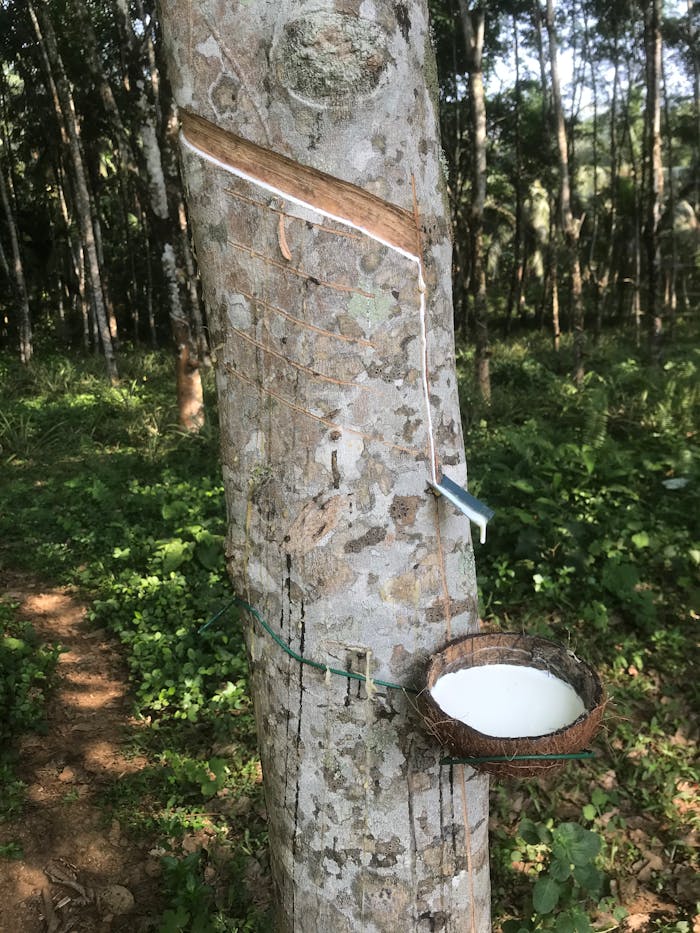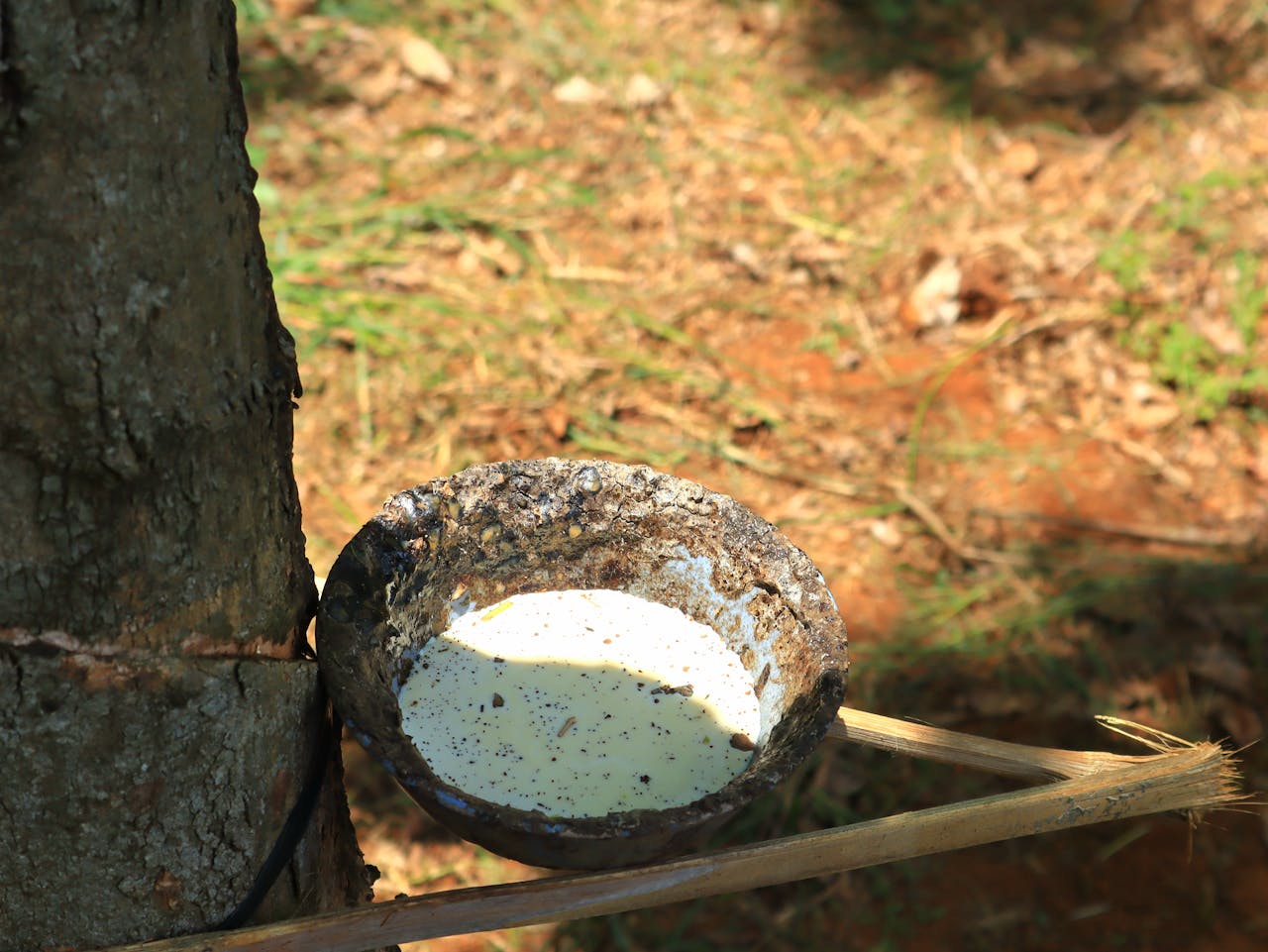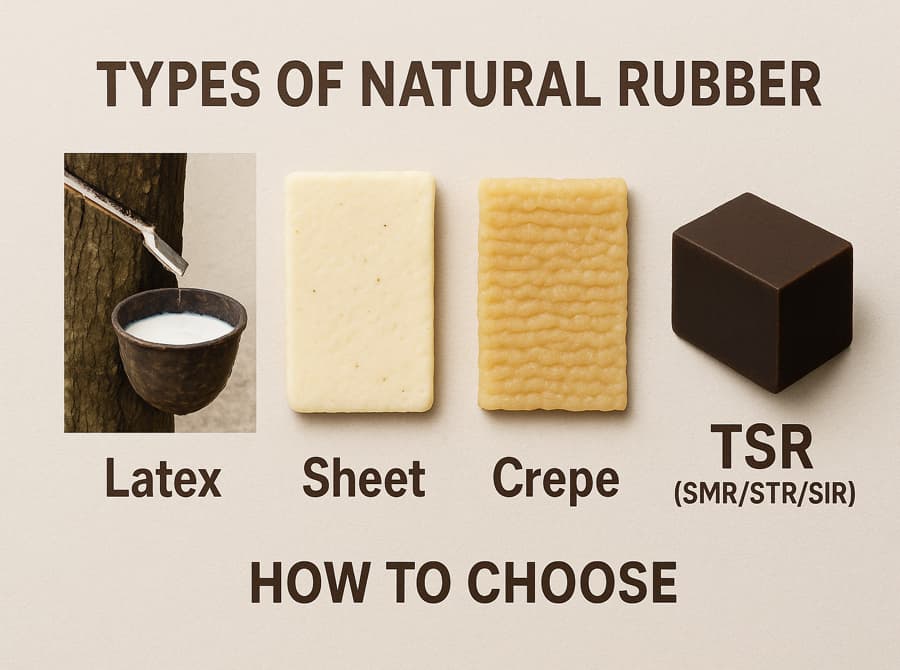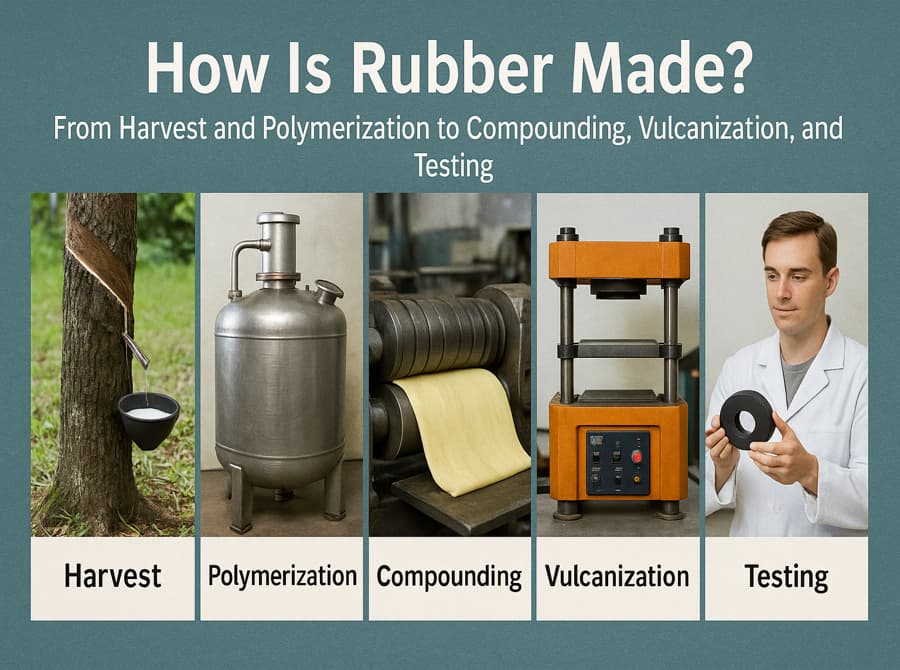Short answer: Rubber is made from elastic polymers (natural cis-1,4-polyisoprene or synthetic elastomers like SBR, NBR, EPDM) that are vulcanized and compounded with carefully chosen chemicals—curatives (sulfur or peroxides), accelerators/activators (e.g., zinc oxide + stearic acid), fillers (carbon black or silica), plasticizers, and antioxidants/antiozonants—to achieve target hardness, strength, chemical/weather resistance, and durability.

Natural vs. Synthetic Rubber—Quick Primer
- Natural rubber (NR) is almost entirely cis-1,4-polyisoprene harvested from the latex of Hevea brasiliensis. Its long chains coil and uncoil, giving excellent elasticity and tear resistance; it’s strong at room temperature but degrades under ozone/UV unless protected.
- Synthetic rubbers are man-made elastomers tailored for specific needs: SBR (general purpose, tires), NBR (oil/fuel resistance), EPDM (weather/ozone/steam resistance), CR neoprene (balanced oil/ozone), IIR butyl (gas impermeability), FKM fluoroelastomer (high-temp/chemicals), VMQ silicone (broad temperature, great flexibility). Names follow ISO 1629 codes (NR, SBR, NBR, EPDM…).
Is rubber a plastic?
Both are polymers, but elastomers (rubbers) stretch and recover with crosslinks; most plastics don’t. Britannica describes rubber as an elastic polymer designed to stretch and recover.
What Rubber Is Actually Made Of (Formulation 101)
Rubber articles are not just the base polymer. A typical compound includes:
- Curatives: Sulfur (classic vulcanization) or peroxides (for heat/chemical resistance). Vulcanization—discovered and patented by Charles Goodyear in 1844—creates chemical crosslinks that lock in shape and resilience.
- Accelerators & activators: Organic accelerators plus zinc oxide/stearic acid activate and speed up cure, controlling crosslink density.
- Reinforcing fillers: Carbon black (abrasion/strength, conductivity trade-offs) or silica (wet grip/low rolling resistance with proper coupling agents) tune modulus, wear, heat build-up.
- Plasticizers/process oils: Adjust viscosity and low-temperature flexibility.
- Antioxidants/antiozonants & wax: Protect against oxygen/ozone cracking; hindered phenols and PPDs are common classes.
Why it matters: Changing filler type or crosslink system can move hardness from 40→90 Shore A, raise tensile strength, or dramatically alter heat/chemical resistance—without changing the base polymer. (See tables below for selection.)
How Properties Are Measured (and Specified)
Engineers and buyers rely on published test methods and standards:
- Tensile strength & elongation: ASTM D412 defines specimen types (dumbbell/cut ring) and procedures for vulcanized rubber and TPEs. Use it to compare strength, modulus, and ultimate elongation across compounds.
- Hardness: ASTM D2240 (durometer Shore A/D/OO…) or ISO 48-4 (IRHD, Shore) measure indentation hardness. 70 Shore A is a common general-purpose hardness for seals and sheets.
- Classification: ASTM D2000 provides a common call-out system (originally for automotive) to describe compounds by heat/aging, oil resistance, and key properties—widely used across industries.
- Nomenclature: ISO 1629 standardizes elastomer abbreviations (NR, SBR, NBR, EPDM…). Use these codes in specs and RFQs. ISO
Spec sheet decoder (mini)
If you see “ASTM D2000: M2BC710 A14 B14 C12 F17”, the line encodes base polymer family and required tests/levels. Request the test report (D412 tensile, D2240 hardness, etc.) from suppliers to verify conformance.
Material Cheat-Sheet: Common Rubbers & Properties
Table 1. Summary of base materials, typical properties, and composition cues
(Ranges are indicative; verify with supplier data sheets & tests.)
| Elastomer (ISO 1629) | What it’s made of / notes | Typical hardness (Shore) | Strength/Temp/Resistance (signals) | Typical uses |
|---|---|---|---|---|
| NR (Natural rubber) | cis-1,4-polyisoprene from Hevea latex; sulfur-cured with antioxidants | 30–80 A | Very high elasticity & tear; fair heat; poor ozone without protection | Tires, isolators, abrasion parts. |
| SBR | styrene-butadiene copolymer; often carbon-black reinforced | 40–90 A | Good abrasion; moderate aging; fair oil resistance | Tires, belts, general goods. |
| NBR | acrylonitrile-butadiene; higher ACN → better oil/fuel resistance | 40–95 A | Good oils/fuels; limited ozone/UV | Fuel/oil seals, hoses. |
| EPDM | ethylene-propylene-diene; saturated backbone | 30–90 A | Excellent ozone/steam/weather; poor fuels/oils | Roof/auto weatherseals, potable water gaskets. |
| CR (Neoprene) | chloroprene polymer | 40–90 A | Balanced oil/ozone/flame; versatile | General-purpose gaskets, cable jackets. |
| IIR (Butyl) | isobutylene-isoprene; low gas permeability | 40–80 A | Excellent air retention; good chemicals; poor oils | Inner tubes, diaphragms. |
| FKM (Fluoroelastomer) | fluorinated copolymers | 60–95 A | High-temp & chemical resistance; premium cost | Chemical/oil seals, powertrain. |
| VMQ (Silicone) | polysiloxane; peroxide/platinum cured | 20 A–80 A | Very wide temp band; excellent flexibility; poor tear/abrasion | Food/medical seals, high-temp gaskets. |
Caption: Composition notes summarize polymer + typical compounding (sulfur/peroxide, fillers, stabilizers). Hardness is measured by ASTM D2240 or ISO 48-4; strength by ASTM D412. Always request supplier certificates.
Use-Cases: Pros & Cons
Table 2. Applications and trade-offs
| Application | Best-fit candidates | Pros | Cons |
|---|---|---|---|
| Outdoor weather seals | EPDM, VMQ | Exceptional ozone/UV; steam tolerance (EPDM) | Fuels/oils attack EPDM; VMQ lower tear strength. |
| Fuel & oil systems | NBR, FKM | Hydrocarbon resistance; FKM for high temp | NBR ozone sensitivity; FKM cost. |
| Abrasion components | NR, SBR | High resilience & wear resistance | Ozone protection needed (NR); heat build-up (SBR). |
| Gas retention | IIR | Very low permeability | Limited oil/fuel resistance. |
| General purpose | CR | Balanced properties | Not best-in-class in any single axis. |
Sustainability & Supply Chain (2024–2025)
- End-of-life tires (ELT): The U.S. reclaimed/recycled ~79% of ELTs in 2023, a notable rebound vs. 2021—good signal for circularity.
- Tight NR supply: Industry groups flagged a 2025 natural rubber shortfall (demand > supply), following 2024 weather-related disruptions and price spikes; expect firmer prices and procurement variability. Consider dual-sourcing (NR/SBR blends) or spec flexibility where feasible.
- Geographies: ~95% of NR plantations are in Asia; smallholders dominate supply—exposure to climate and price cycles.
How to Choose the Right Rubber (Checklist)
Table 3. Material selection checklist
| Criterion | What to decide | Where to look / test |
|---|---|---|
| Media & chemicals | Oils/fuels, water/steam, acids/alkalis, ozone/UV | Polymer family (ISO 1629); supplier compatibility charts |
| Temperature profile | Continuous, peaks, cold starts | ASTM D2000 call-out & supplier data |
| Mechanical demands | Strain, cyclic fatigue, abrasion | ASTM D412 tensile/elongation; field history |
| Hardness & compression set | Target Shore A/D; permanent set limits | ASTM D2240 (Shore), supplier compression-set data |
| Regulatory/food contact | REACH, FDA, potable water | Supplier certifications; migration tests |
| Environment & lifetime | Ozone/UV, weather, fluids, maintenance | Additives (antiozonants/antioxidants), wax bloom |
| Verification | Require test reports | ASTM D412/D2240 data; D2000 conformance |
Tip: If you don’t have a spec yet, start by writing the ISO 1629 code + hardness + key media + temp (e.g., “EPDM 70A, steam exposure to 140 °C”), then map to an ASTM D2000 call-out with your supplier.
FAQ (People Also Ask-style, 8 Q&As)
- Is rubber a plastic or a polymer? Rubber is an elastomeric polymer; unlike most plastics it stretches and recovers via crosslinks.
- What is natural rubber made of? Mostly cis-1,4-polyisoprene from Hevea brasiliensis latex.
- What chemicals are added to rubber? Curatives (sulfur/peroxide), accelerators/activators (ZnO, stearic acid), fillers (carbon black/silica), plasticizers, antioxidants/antiozonants.
- How is rubber hardness measured? Durometer per ASTM D2240 or ISO 48-4; common consumer hardness is Shore A.
- How do I specify a rubber compound? Use ISO 1629 codes and, where applicable, an ASTM D2000 call-out with verified test data (D412, D2240).
- Who invented vulcanization? Charles Goodyear patented it in 1844.
- Is natural rubber supply tight in 2025? Industry reports point to a continued shortfall vs. demand in 2025.
- Are tires really recycled? In the U.S., ~79% of ELTs were reclaimed/recycled in 2023.


